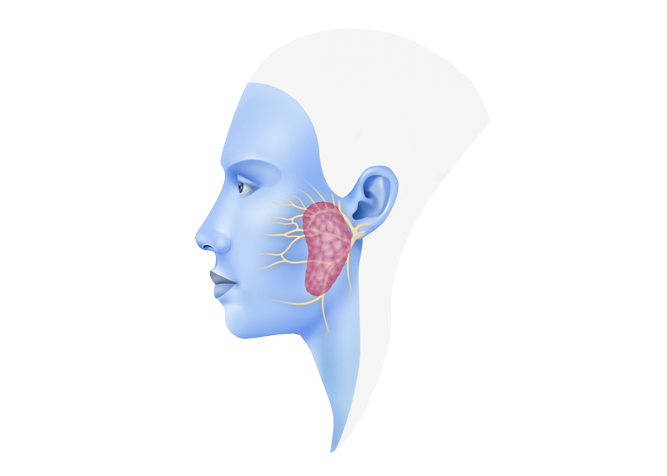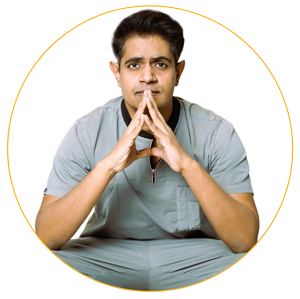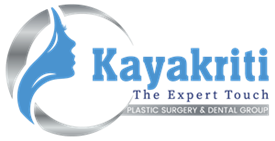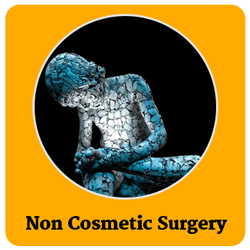Parotid Tumor
Parotid Glands are salivary glands situated just in front of the ears on each side of the face.

Best Parotid Tumor Surgery in India
What are parotid glands?
Parotid Glands are salivary glands situated just in front of the ears on each side of the face. So, they are 2 in number. The importance of salivary glands is the secretion of saliva, which contains salivary enzymes aiding in digestion, keeping the mouth moist & promotes healthy dentition.
There are 3 types of major salivary glands below and behind the jaws-
- Parotid
- Sublingual
- Submandibular
Many other tiny salivary glands are present in the lips, inside the cheeks, and throughout the mouth and throat.
What is a Partoid tumor?
The tumors of Parotid Glands are most common amongst all the salivary gland tumors. Abnormal growth of cells in the parotid glands is called Parotid Tumor. Though most of them are non-cancerous but can transform into cancerous conditions.
Type of Partoid tumor
They can arise either from the Parotid Glands itself or can metastasize from other parts. They are mainly of 2 types-
- Benign tumors - Typically non-aggressive cell growths that result from a variety of aberrant intracellular events within the gland. These tumors typically grow slowly over time, are painless, and do not invade or destroy adjacent tissues. They can compress adjoining structures and cause malfunction of surrounding structures based purely on their space-occupying effects.
- Benign parotid tumors - can undergo malignant transformation over time if not treated on time. Malignant transformation alters prognosis and affects treatment protocols considerably.
The most common type of Parotid Tumor is the Pleomorphic Adenoma, which is a slow-growing benign tumor having very low chances of malignant transformation.
Types of Salivary Gland Tumors
A) Types of noncancerous (benign) salivary gland tumors include
- Pleomorphic adenoma- most common
- Basal cell adenoma
- Canalicular adenoma
- Oncocytoma
- Warthin's tumor
B) Types of cancerous (malignant) salivary gland tumors include
- Acinic cell carcinoma
- Adenocarcinoma
- Adenoid cystic carcinoma
- Clear cell carcinoma
- Malignant mixed tumor
- Mucoepidermoid carcinoma
- Oncocytic carcinoma
- Polymorphous low-grade adenocarcinoma
- Salivary duct carcinoma
- Squamous cell carcinoma
What are the Symptoms Of Parotid Tumor
Symptoms of benign parotid tumor
- A lump or swelling on or near the jaw, neck, or mouth.
- Usually, a painless swelling
- Asymmetrical face.
- Fullness or swelling of the cheek.
- The sensation of fullness of Parotid Gland.
Symptoms of Parotid cancer or if a benign tumor turns into Parotid cancer
The patient will develop one of more of the following symptoms-
- Painful swelling in the region of the parotid gland.
- Sudden onset of pain in the swelling of the parotid gland.
- Difficulty in swallowing food
- Numbness in part of the face.
- Muscle weakness on one side of the face leads to Paralysis of one side of the face.
- Trouble opening mouth widely
- Difficulty in speech.
- Unexplained weight loss, fever, and night sweats.
What causes Parotid Tumor?
- The main cause is unknown.
- Genetic predisposition is being researched.
- It can metastasize from other parts of the body.
- Smoking is also a contributing factor.
Risk Factors for developing Parotid tumor
- Age Factor - Though it can happen at any age but is most common in elderly people.
- Radiation Exposure - Increased radiation exposure in patients under radiotherapy.
- Occupational Hazard - Jobs associated with salivary gland tumors include rubber manufacturing, asbestos mining, and plumbing.
Diagnosis of Pleomorphic adenoma
- Patient History - In-depth history is important for finding out the symptom onset, frequency, intensity, aggravating factors & associated activities.
- Physical Examination - The jaws, neck & throat need to be palpated for any kind of lump or swelling.
- Fine Needle Aspiration (FNA)/Biopsy - FNAC/Biopsy can provide relevant diagnostic information about the tumor whether it is cancerous or non-cancerous. During FNAC, small glandular tissue samples are obtained and examined by microscopy to determine the cellular integrity of the salivary gland. This information can provide a definitive diagnosis or rule out suspicion of cancer.
- Sialendoscopy - Ductal evaluation via sialendoscopy is an innovative minimally invasive diagnostic procedure helpful in assessing salivary gland dysfunction, including obstructive disease of the salivary gland duct system. Invasive cancer or other benign growths can obstruct or compress the ductal system.
- Ultrasound, MRI & CT Scan can be done to understand the size of the tumor and the extent of involvement of the tumor.
Dr Amit Agarwals focus during consultation
- Discussion about chances of facial nerve injury or palsy during surgery leading to weakness or paralysis of one side of the face. It could be transient due to stretching or pressure over the nerve which gets auto-corrected within 3 to 6 months. It can also be a permanent injury but the chances are very rare (less than 1 percent).
- Surgical options can be customized accordingly if the tumor is benign and not extensive and if the patient is not willing to accept any risk of facial nerve injury.
- Discussion with the patient is also done regarding post-surgical follow-ups, prognosis, and any treatment required after the surgery.
What are the surgical options for Parotid tumor?
Any of the following surgical options are advised to the patient depending on the tumor type, location, and chances of facial nerve involvement.
- Superficial Parotidectomy - most commonly advised and done surgery for parotid tumors. In superficial parotidectomy, the parotid gland above the level of the facial nerve is removed and the nerve is preserved. Chances of temporary paresis of the facial nerve are there or injury to one or two branches of the facial nerve is possible owing to difficult dissection of the tumor.
- Extracapsularlar resection of tumor - A tumor with some of the healthy parotid gland tissue is removed. It is done in patients with a small tumor in the superficial lobe and also for those who do not want superficial parotidectomy and are not willing to accept any chances of facial nerve injury associated with it. The chances of recurrence are relatively higher than superficial parotidectomy but this is considered a better surgery than enucleation.
- Total Parotidectomy - In the case of large tumors involving deeper parts of the parotid, cancers, or tumors with nerve involvement -complete removal of the parotid is done with the removal of the facial nerve. The nerve can be reconstructed in the same setting with the help of nerve grafts taken from the leg.
Dr. Amit Agarwal specializes in nerve-sparing total parotidectomy
General anesthesia is administered. Then the incision is placed in the crease of the neck or hidden along the earlobe & hairline, similar to a facelift procedure. Parotid Gland with some adjacent tissue is removed preserving the nerve. The closure is done in layers over a light suction drain.
- Extensive Surgery - If parotid cancer has metastasized into nearby skin and muscles and distant bones and organs, a more extensive operation is performed. All cancer and a small amount of the healthy tissue that surrounds it is removed. Then these invaded areas are reconstructed with microvascular surgery.
Recovery after Parotid Tumor Surgery
How much time does it take to Recover?
- Patients can be sent back home the next day or the day after surgery.
- To ensure that blood & fluid do not accumulate in the face & neck region, a drain might be placed in the incision which can be removed at an elective date later in follow-up.
- One to two weeks of the post-operative recovery period is recommended.
- Sutures are usually removed after a week of surgery.
What to do for faster Recovery?
- Avoid heavy lifting & straining.
- Keep the wound clean & dry.
- Do not worry about temporary paralysis of the facial nerve. It takes time but will recover on its own in the majority of cases.
Other Options
Radiation and chemotherapy for Parotid tumors
- Radiation therapy - It uses powerful beams of energy, such as X-rays, protons, or neutrons, to kill cancer cells. If the parotid tumor is cancerous, radiation therapy might be recommended after surgery to kill any cancer cells that remain. Radiation therapy is sometimes used as an initial treatment when surgery isn't an option for advanced tumors.
- Chemotherapy - It is a drug treatment that uses medications to kill cancer cells. It's not routinely used to treat parotid tumors, but sometimes it's combined with radiation therapy to treat parotid cancers that have a high risk of spreading or cancers that can't be entirely removed with surgery. Chemotherapy might also be an option for people with advanced parotid cancers that have spread to other parts of the body.
Risk and complications after Parotid Tumor
- Bleeding.
- Infection.
- Scarring.
- Salivary fistula - Saliva leaking through the incision.
- Sialocele - Cavity or cyst containing saliva.
- Frey's syndrome - a rare complication of parotid gland surgery that causes sweating or flushing in an area of the face when eating, especially spicy, salty or sour foods.
- Seroma - Pocket of serum that forms near the surgical incision.
- Facial nerve injury leads to weakness or paralysis of one side of the face.
Know your surgeon better

Best plastic surgeon, Dr. Amit Agarwal is an American Board Certified, extensively trained, and best Plastic & Aesthetic surgeon in Lucknow. He is the Chief Plastic Surgeon heading the Department of Plastic, Microvascular, and Craniofacial surgery at Vivekananda Polyclinic and Institute of Medical Sciences, Lucknow, U.P, India. He maintains a busy practice at Avadh and Nishat Hospital and his own center - Kayakriti Plastic Surgery & Dental Center. He was formerly a Consultant in the Department of Plastic Surgery and Burns at the prestigious SGPGI, Lucknow.
MS, DNB (General Surgery) MCh, DNB (Plastic Surgery),
MNAMS, FACS, FICS, FRCS (Edinburgh, UK)
His Credentials
Three pillars of kayakriti
Privacy
We believe your experience with us should be comfortable and hassle-free to make it one of your best lifetime experiences for yours. We, here at the clinic, take full precautions to maintain your privacy in any manner. We also provide a staff who will receive you from the gate and take you to the chamber directly if you demand.
Trust
Our Surgeon is highly qualified and internationally certified with a team of skilled staff to perform any surgical or non-surgical treatment on your body.
Safety
When you plan to undergo any surgery you should always keep in mind that it's your body and it's a surgery. We, here always keep your safety a priority and will never recommend you to undergo any such procedure which is not safe for you. We also provide you with a detailed description of the complications which may occur after the surgery during the consultation as it's a surgical procedure so there may be some complications depending on the way your body reacts.
Kayakriti in news



Frequently Asked Questions
If you have flat or small breast and you want to improve your breast and hip contour ratio then you are a good candidate for it. The answer will be best provided after the first consultation with Dr Amit Agarwal.
Acute pain will be there for almost a week which gradually reduces and there will be soreness and swelling which may take up to 3 weeks to subside.
You can join your work and daily routines after a week of the procedure and can start exercising after 3 weeks of it.
Yes, you have to wear it round the clock unless we suggest you to remove it.
This surgery does not affect the ducts or the areas of the breast involved in milk production. Thus, it does not affect the breast feeding.
This surgery does not affect the ducts or the areas of the breast involved in milk production. Thus, it does not affect the breast feeding.












Kayakriti Plastic Surgery & Dental Center
D-43, Near Punjab National Bank, Rajajipuram, Lucknow, Uttar Pradesh - 226017, India
Phone No. +919695940009, +919695940006
Map Location





























Social Media Presence